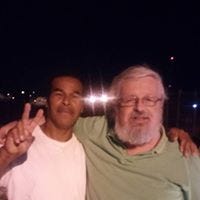by Cindy Knoebel
Recently, CIVIC (Community Initiatives for Visiting Immigrants in Confinement) volunteer Cindy Knoebel interviewed Bud Conlin, Coordinator of Friends of Miami-Dade Detainees, to learn more about the program — and his personal experience with visiting immigrants in detention.
Cindy Knoebel: You first conceived of the idea for FOMDD after a visit you and a small group made to the Krome Service Processing Center in Miami in the spring of 2013. What was that visit like?
Bud Conlin: It was horrible. The facility reminded me of a warehouse for cattle — a place to keep livestock, not human beings. There is a firing range at the facility and we could hear automatic rifles firing all day. And there are no soft surfaces — everything is hard. No one has a name; you’re just, like, “Guatemala 328.” I remember one guy I met that day; I’ll call him “Francois.” For the next three years, I watched him deteriorate. Then he got deported.

CK: And from that initial visit, you decided to lead the charge for a visitation program at Krome?
BC: Yes. It took months to work out the procedures with ICE. Our first official visit took place on February 13, 2014. Since then, our volunteers (we currently have eighteen) have made over 2,000 visits. Each week about twenty-five men at Krone request visits — and we try to meet with every one we can.
CK: What do your volunteers say about the mindset of those they visit?
BC: The emotions of the men in confinement are all over the place. You’ll hear denial, resignation — everything. But the guys who ask for visitors? They’re the survivors. They want that connection with the outside — and they’ll ask for it week after week. They know it’s important.
CK: What’s a typical visit to someone at Krome like?
BC: Well, we have to go through all the security procedures — show IDs, empty our pockets, go through the metal detectors, lots of paperwork. Then there’s the long walk down the corridor to the visitation area with its Plexiglas and phones. We meet with the men, learn about who they are. We cite the FOMDD goals, check to see if they have an attorney, ask about their families. Sometimes they’re a little confused about who we are and why we’re there — maybe even suspicious — but gradually they relax and begin to talk. Some sense the clock is ticking, and they’ve lost hope that they’ll ever be released back to their families. But we encourage them to always have hope. We tell them about Viktor Frankl, a psychiatrist, neurologist, and Holocaust survivor, whose research showed that folks with a more positive vision of the future are the most likely to survive dehumanizing situations. Sometimes we teach those we visit how to meditate. Basically, for one hour, we’re there to carry their loads.

CK: In addition to visits, how else does FOMDD assist detained immigrants?
BC: Money is always an issue for the men held at Krome — or at any detention facility — so we’ll try to get funds added to a phone card. We’ll send paperback books, or gather clothes for someone who’s about to be deported. Often, those released are dumped in the middle of nowhere. So we’ll help find them a place to spend a night or two. And we also assist with their report-ins.
And if we can do more, we do. For example, we worked with a Somali man to bring his story to the attention of a reporter, which in turn resulted in him obtaining legal support. But the hitch was his bail was eventually set at the outrageous sum of $20,000. We started a Go Fund Me campaign but couldn’t raise the total amount. Finally, we found a very generous individual who agreed to put the remaining amount on his personal credit card as an authorization. Today, the Somali man is living in an immigrant shelter in Texas and working as an aide for the elderly and disabled. And he’s got a lawyer from a big firm working for him pro bono.
CK: If someone were to ask you why you visit immigrants in detention, how would you respond?
BC: We visit for four reasons. First, to let them know we know they are there. Second, to make life less bad. Next, to raise community awareness through networking and community outreach. And finally, to provide a level of oversight over the actions of ICE in our county.

CK: Is there one particular person’s story at Krome that’s stuck with you?
BC: There’s this one man, let’s call him Divine, who’s from South Cameroon. I began talking to him six months ago. He’s an anthropologist, a committed non-violent activist and part of a movement seeking peaceful secession from Cameroon. He was forced to flee the country, leaving his wife behind. A few weeks ago, his father was murdered. We know Cameroon is a violent place, and the men and women who come to the United States are only trying to seek asylum, yet we sent them back all the time. But he’s working hard and studying his case; I’ve talked to his wife and I’m hoping he’ll find a good lawyer who can help him make his case for asylum.
CK: If there were one thing you’d like our readers to know about FOMDD, what would it be?
BC: That we’re committed to ending isolation in all of its forms. Really, “end isolation” — that’s the key phrase. It’s magical.

